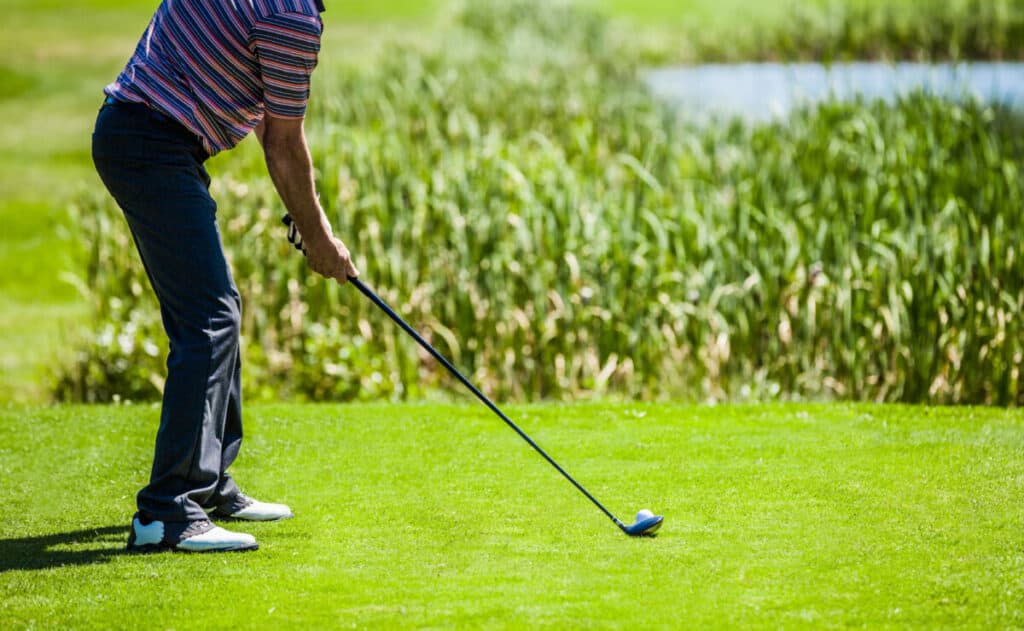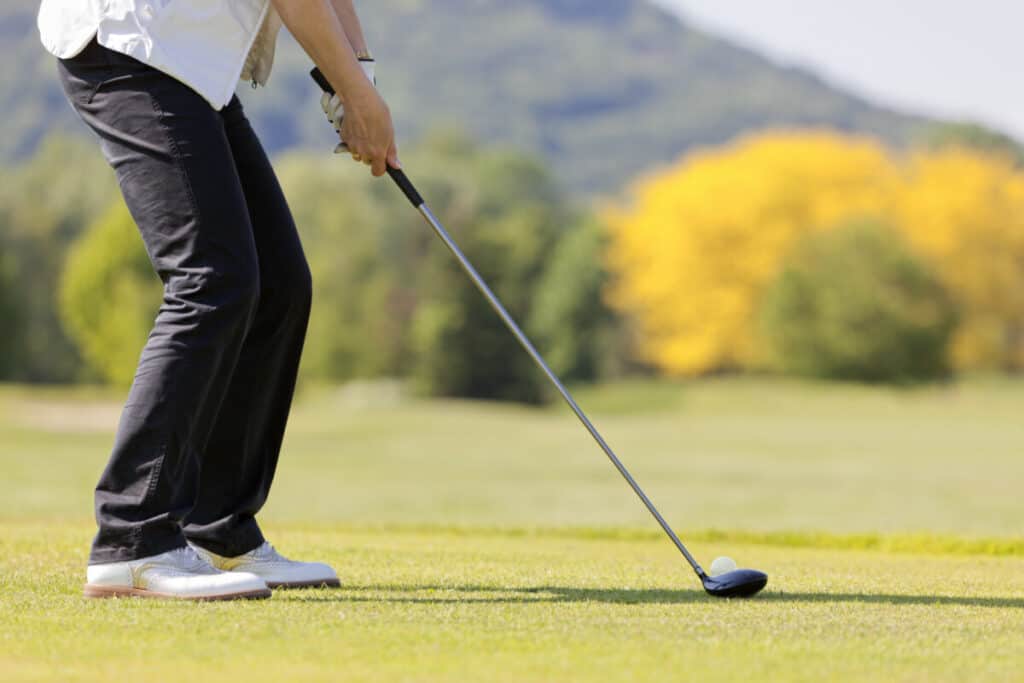Hybrids vs. Fairway Woods – FULL Distance and Comparison Guide

The introduction of golf hybrids over the past couple of decades has given golfers a genuine alternative to fairway woods and long irons which have often proved difficult for all standards of players to hit consistently well.
With increased choice however also comes increased challenges in terms of finally deciding which clubs to put in your golf bag and the key metric golfers naturally want to consider when thinking about whether to replace fairway woods with hybrids is distance.
Do hybrids go as far as woods or vice versa and therefore are you compromising distance if you choose a hybrid to replace one of your fairway woods?
As a general rule woods go further than equivalent hybrids when both clubs are hit off the tee. These distance gaps however are reduced for approach shots and indeed the trend is reversed in the case of 5-wood versus 3-hybrid approach shots where all handicap groups hit 3-hybrids the same distance or up to 9 yards further.
While such general distance comparisons are undoubtedly useful it is vital that any player is clear on their underlying basis.
So in this post we analyse in detail distance stats from the largest set of amateur golf data in the world comparing hybrids vs. fairway woods and also explore the other considerations they should take into account before making any final decision on which fairway woods and hybrids to pick.
[Note – If you are interested in Arccos – Golf’s first artificial intelligence shot tracking platform – and getting an exact idea of how far you hit the ball so you choose the right club every time click here to get 15% off when you use our discount code – GOLFINGFOCUS15. Recognised by Golf Digest Editor’s awards 5 years running Arccos’ members improve by an average of 5 strokes in their first year of membership!]

Hybrids vs. 3 Wood – What Replaces It & Distances?
When it comes to comparing hybrid distances with fairway woods it is absolutely vital that you are comparing like with like.
Manufacturers have been messing about with the lofts of clubs for a long time now so when it comes to assessing hybrid distances against fairway woods it is important to be clear on the loft of the hybrid you are intending to potentially replace with the equivalent wood.
While different companies in general put the iron number on the hybrid it is supposed to replace this is not an absolute rule and this does not of course help us when it comes to considering what wood a hybrid is equivalent to.
As a general rule a 1-hybrid, of loft 14º to 16º, is equivalent to a 3-wood. A 2-hybrid, lofted between 17º to 19º is intended to replace a 4-wood while a 3-hybrid of 19º to 21º loft is meant to replace a 5-wood. Further up the bag a 7-wood can be replaced with a 4-hybrid and a 5-hybrid is equivalent to a 9-wood.
While you will undoubtedly find exceptions to these numbers they stand as a good guide and we have also included the irons various hybrids are equivalent to, and can replace, in the table below.
| HYBRID CLUB | HYBRID LOFT | EQUIVALENT IRON / WOOD |
| 1 Hybrid | 14-16 degrees | 1 iron / 3 wood |
| 2 Hybrid | 17-19 degrees | 2 iron / 4 wood |
| 3 Hybrid | 19-21 degrees | 3 iron / 5 wood |
| 4 Hybrid | 22-24 degrees | 4 iron / 7 wood |
| 5 Hybrid | 25-27 degrees | 5 iron / 9 wood |
| 6 Hybrid | 29-31 degrees | 6 iron / 11 wood |
| 7 Hybrid | 32-34 degrees | 7 iron / 13 wood |
If we bear this in mind therefore when we turn our attention specifically to hybrid vs. 3-wood distance comparisons we can see that it is the 1-hybrid that is closest in direct loft comparison.
Saying that however very very few players use a 1-hybrid, for the same reason that very few players, and most famously six-time major champion Lee Trevino, never used a 1-iron.
They are very hard to hit consistently well.
“If you are caught on a golf course during a storm and are afraid of lightning, hold up a 1-iron. Not even God can hit a 1-iron.”
— Lee Trevino, World Golf Hall of Famer
[Editor’s note – In our detailed analysis of the hybrids being used by the top 100 players on the PGA Tour we found only one player to be using a hybrid lofted less than 17º. Interestingly that same player was using a 2-hybrid club but with the loft adjusted from 17º to 15.5º. Check out the full analysis here.]
So when it comes to comparing hybrid and 3-wood distances the most practical comparison is with a 2-hybrid which is much more commonly used.
And thankfully today there is a lot of tech which can help us with these distance comparisons and this includes Arccos, golf’s first AI shot tracking platform, which now boasts over 500 million amateur golf shots from across the world in its database.
In the past only the pros have had access to good quality distance data when it comes to looking at exactly how far they hit their clubs but in the modern game it’s a different story.
And it’s such a different story that systems such as Arccos are able to compare 2-hybrids vs. 3-wood distances both for tee shots and approach shots and this data is detailed in the tables below.
| HANDICAP | 3-WOOD ‘TEE SHOT’ AVERAGE TOTAL DISTANCE | 2-HYBRID ‘TEE SHOT’ AVERAGE TOTAL DISTANCE | DIFFERENCE |
| 0-5 | 215 yards | 204 yards | 11 yards |
| 6-10 | 200 yards | 184 yards | 16 yards |
| 11-15 | 186 yards | 172 yards | 14 yards |
| 16-20 | 171 yards | 151 yards | 20 yards |
| 20+ | 155 yards | 138 yards | 17 yards |
| HANDICAP | 3-WOOD ‘APPROACH SHOT’ AVERAGE TOTAL DISTANCE | 2-HYBRID ‘APPROACH SHOT’ AVERAGE TOTAL DISTANCE | DIFFERENCE |
| 0-5 | 191 yards | 187 yards | 4 yards |
| 6-10 | 180 yards | 176 yards | 4 yards |
| 11-15 | 170 yards | 165 yards | 5 yards |
| 16-20 | 160 yards | 156 yards | 4 yards |
| 20+ | 142 yards | 143 yards | (1 yard) |
On average all handicap groups hit 3-wood further than a 2-hybrid by a total distance of 15.6 yards according to Arccos when both clubs are hit off the tee. 2-hybrid ‘approach shots’ do not go as far as 3-wood approaches by only 4 yards for 0 to 20 handicappers while 20+ handicappers actually hit 2-hybrid one yard further.
So as we can see from these stats a 2 hybrid does not go as far as a 3-wood, and perhaps obviously so when you consider the loft difference between standard versions of the same club.
However when we look in more detail we can also see the distance difference is much reduced when it comes to comparing the clubs when hit off the tee compared to approach shots.
So if you are considering a 2-hybrid as a replacement or as a supplement to your 3-wood it would seem sensible to consider the types of shots you are most likely to use each club for.

Hybrids vs. 5 Wood – Which Go Further?
When it comes to considering the potential hybrid replacement or equivalent for a 5-wood we can see from the loft analysis detailed above that it is the 3-hybrid this time that comes under consideration.
And when it comes to looking at the distance question and how a 3-hybrid compares to a 5-wood, and whether it goes as far, we are again able to turn to the detailed data made available by Arccos for ‘tee shots’ and ‘approach shots’ with both clubs.
| HANDICAP | 5-WOOD ‘TEE SHOT’ AVERAGE TOTAL DISTANCE | 3-HYBRID ‘TEE SHOT’ AVERAGE TOTAL DISTANCE | DIFFERENCE |
| 0-5 | 188 yards | 189 yards | (1 yard) |
| 6-10 | 182 yards | 175 yards | 7 yards |
| 11-15 | 168 yards | 159 yards | 9 yards |
| 16-20 | 152 yards | 147 yards | 5 yards |
| 20+ | 137 yards | 132 yards | 5 yards |
| HANDICAP | 5-WOOD ‘APPROACH SHOT’ AVERAGE TOTAL DISTANCE | 3-HYBRID ‘APPROACH SHOT’ AVERAGE TOTAL DISTANCE | DIFFERENCE |
| 0-5 | 175 yards | 175 yards | 0 yards |
| 6-10 | 169 yards | 171 yards | (2 yards) |
| 11-15 | 159 yards | 161 yards | (2 yards) |
| 16-20 | 151 yards | 153 yards | (2 yards) |
| 20+ | 132 yards | 141 yards | (9 yards) |
As a whole amateurs hit 5-wood ‘tee shots’ 5 to 9 yards further than a 3-hybrid on average except for 0 to 5 handicappers who hit them the same distance. This group again hit 5-wood and 3-hybrid the same distance for ‘approach shots’ but all other handicap groups hit 3-hybrid approaches 2 to 9 yards further than 5-wood.
These numbers are interesting from a couple of perspectives.
Firstly for excellent low handicap golfers there appears to be no difference between the distances they hit their 5-wood and 3-hybrid in whatever circumstance they are using those clubs on the course and this is most likely explained by the far greater consistency with which they strike the ball than higher handicappers.
Secondly, and perhaps more interestingly however, is that all the other handicap groups clearly are more confident on average when using 3-hybrid from the fairway compared to off the tee.
The distance gains realised when using 5-wood compared to 3-hybrid off the tee for these players are reversed when using those same clubs from the fairway or rough for approach shots and as such this should be a consideration for you when choosing which of these two clubs you may want to play with.
If you are not planning to hit either club off the tee on very many occasions the 3-hybrid is likely your better choice if you are looking for more distance!

When it comes to alternatives to an easy-hitting long wood such as a 5-wood many golfers also consider whether a 4-hybrid is another option and how the distances compare between the two clubs.
As we have seen from the loft comparison above a standard 4-hybrid will be a higher lofted club than a standard 5-wood but for the sake of completeness we took a look at the Arccos data also for 4-hybrids to confirm which goes further.
In total a 5-wood goes further than a 4-hybrid by close to 15 yards on average when both clubs are played off the tee according to Arccos, the largest set of amateur golf data in the world. This difference however drops to just under 5 yards of total distance on average for 5-wood vs 4-hybrid approach shots.
So when it comes to comparing 5-wood vs 4-hybrid distances it is clear that a 5-wood consistently goes further across all handicap groups although we also noted that the smallest differences were found amongst the highest handicap players both for tee shots and approach shots.
A complete breakdown of 5-wood vs. 4-hybrid ‘total’ distances broken down by handicap categories is listed in the tables below.
| HANDICAP | 5-WOOD ‘TEE SHOT’ AVERAGE TOTAL DISTANCE | 4-HYBRID ‘TEE SHOT’ AVERAGE TOTAL DISTANCE | DIFFERENCE |
| 0-5 | 188 yards | 171 yards | 17 yards |
| 6-10 | 182 yards | 163 yards | 19 yards |
| 11-15 | 168 yards | 152 yards | 16 yards |
| 16-20 | 152 yards | 140 yards | 12 yards |
| 20+ | 137 yards | 128 yards | 9 yards |
| HANDICAP | 5-WOOD ‘APPROACH SHOT’ AVERAGE TOTAL DISTANCE | 4-HYBRID ‘APPROACH SHOT’ AVERAGE TOTAL DISTANCE | DIFFERENCE |
| 0-5 | 175 yards | 169 yards | 6 yards |
| 6-10 | 169 yards | 163 yards | 6 yards |
| 11-15 | 159 yards | 155 yards | 4 yards |
| 16-20 | 151 yards | 144 yards | 7 yards |
| 20+ | 132 yards | 131 yards | 1 yard |
Replace Woods with Hybrids? Don’t Focus Only On Distance
Distance is key in golf. There is no question about it.
The stats across all standards of the game, amateur and professional, highlight a clear link between the distance you hit the ball and how low you score.
Saying that however simply working out which club goes further is not the only factor when it comes to considering whether to replace one or two of your fairway woods with a hybrid.
Distance gaping is key to look out for in addition to total distance so if you already hit a fairway wood consistently well a certain distance there may be little point in adding a hybrid to your bag which is only a couple of yards different.
You need good distance gaps between your clubs throughout your bag to be able to cover as many shot distances as possible.
Once you are clear on the distance gaps the differing clubs will give you, the choice simply comes down to which club gives you the results you want.
Do you want a club that you are going to use as an alternative to your driver off the tee or is it going to be focused on approach shots in which case the higher trajectory of the hybrid may suit better?
If it’s an alternative tee shot club you are looking for you may want to bear in mind that according to Arccos’ stats, for every handicap bracket, the 3-wood is the winner in fairway hit percentage, and for all handicaps under 20 the clear winner.
This often runs contrary to the many golfer’s thinking that higher handicap players especially should automatically ditch the 3-wood in favour of hybrids.
As a fairway finder versus a 2-hybrid and 3-hybrid, the 3-wood is the clear champ.

If it’s approach shots however you are looking to potentially swap out a fairway wood for a hybrid the numbers show the 2-hybrid hits more greens than a 3-wood across all handicaps.
And given as we have seen above the distance differences between woods and hybrids are much closer for approach shots compared to tee shots this could mean you are not giving up much distance by choosing a hybrid over the fairway wood.
Remember also fairway woods are longer than hybrids which are designed to be only slightly longer than their comparable irons so that’s something to check you don’t mind.
Whatever you decide finally though just remember to watch out for the distance gaps across all your clubs!
[Note – If you are interested in being taken through some practical guidelines, including the ’24/38 rule‘, to help you answer the question about how many hybrids you need check out our post here.]
Other top posts related to this topic:
- How Far Should You Hit a Driver? FULL GUIDE By Age, Handicap etc.
- Why Don’t Your Drives Go Far? Slow and Steady Loses the Race
- Ideal Spin Rate and Launch Angle for Driver? That’s Personal!
- How Far Should Your Driver Swingspeed Go? 60 to 120 mph Guide
- How Far Should Your Ball Speed Go? 100mph All the Way to 210mph!
- How Much Does Driver Loft Affect Distance? Loft is Dynamic Too!
- How Far Does a 3 Wood vs 5 Wood Go? Tee and Approach Shots!
- How Far Should I Hit My Hybrids? 2 vs 3 vs 4 Hybrid Distances
- How Far Should I Hit My Irons? By Handicap, Age & Swingspeed
- How Far Should You Hit Your Wedges? Be Sure to Fill the Gaps!
- What Hybrids Should You Carry? It’s All About Ego
- Are Hybrid Irons Easier to Hit? 7 Reasons to Choose the Easy Way
- What is the Most Difficult Golf Club to Hit? Take it Easy!
- How Far Do Pro Golfers Hit Each Club?
- How Do Pros Hit the Ball So Far? It’s Not About the Equipment!
- The Fairway Woods Used by the Top 100 PGA Tour Pros
- What Hybrid Golf Clubs Do the Top 100 PGA Tour Pros Use?
- Do Distance Balls Go Further? Marketing Matters
- Do All Golf Balls Go the Same Distance? Physics First
RECENT ARTICLES
LEGAL INFORMATION
This site is owned and operated by Golfing Focus Limited, a private limited company whose registered office is in London, UK. Golfing Focus Limited is a participant in the Amazon Services LLC Associates Program, an affiliate advertising program designed to provide a means for sites to earn advertising fees (at no cost to you) by linking to Amazon.com. Golfing Focus Limited also participates in other affiliate programs with the eBay Partner Network, FlexOffers, CJ.com, Svorn and other sites and is compensated for referring traffic and business to these companies (again at no cost to you).
Our Socials






Leave a Reply